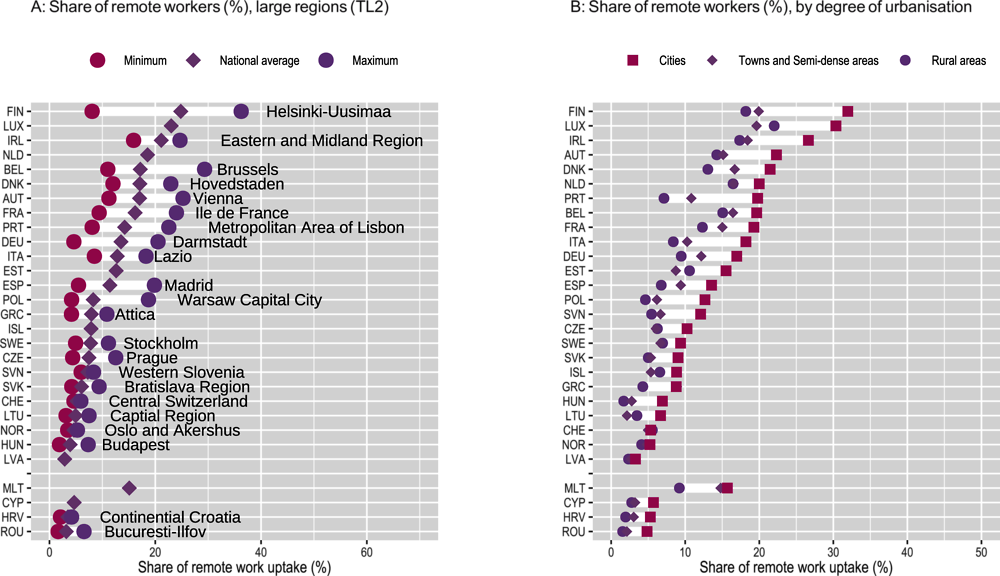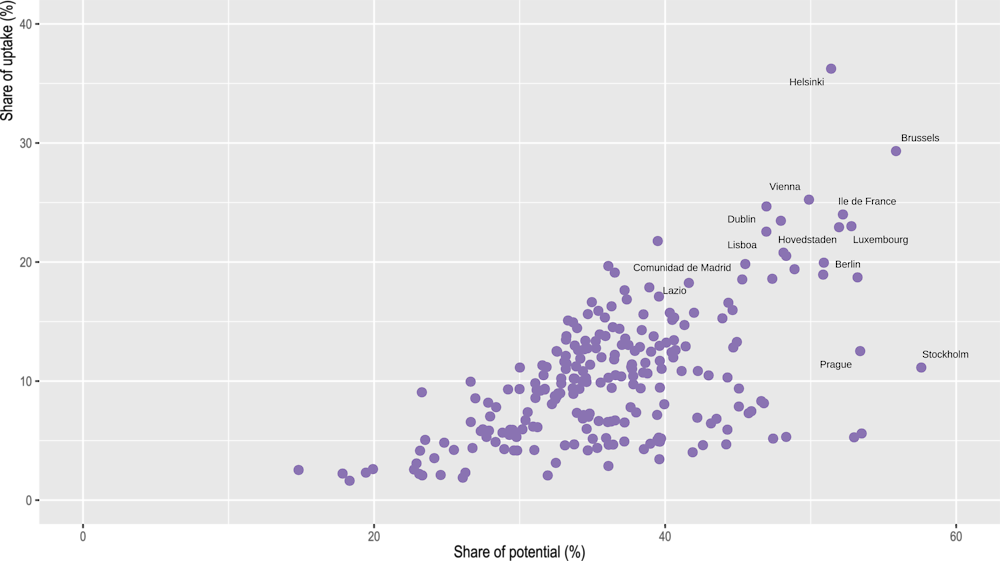Cities and capital regions experienced the largest increase in remote work.
The COVID-19 pandemic has changed how and where people work. Measures taken to contain the spread of the virus, such as social distancing and mandatory lockdowns, forced firms and workers to rapidly implement remote work by adopting new technologies and changing typical work practices. Although those changes were in response to the initial shock of the pandemic, it now seems clear that remote working will remain much more widespread than in pre-pandemic times (Aksoy et al., 2022).
Throughout 2020, over 12% of employees in European countries worked remotely most of the time (50% of the time or more) and another 10% worked remotely from time to time (less than 50% of the time). However, the share of remote work uptake was not homogenous across or within European countries. For example, while 25% of employed people worked from home in Finland, only 3% did so in Latvia (Figure 4.7, Panel A). Within countries, the average gap between the regions (TL2) with the highest and lowest shares of individuals working remotely was close to 10 percentage points. Regional gaps reached more than 15 pp in Belgium, Finland and Poland, driven by the much higher remote work uptake in those countries’ capitals. Overall, in all European countries, cities and capitals had the highest share of remote workers in 2020 (Figure 4.7, Panel B). On average, 20% of workers in capital regions worked remotely most of the time in 2020 compared to only 10% in all European regions.
Cities and capital regions were the faster adopters of remote working during the first year of the pandemic (from 2019 to 2020). Across European regions, on average, the share of remote workers more than doubled, while it tripled in capital regions. Changes in remote work uptake are also significant by degree of urbanisation. Between 2019 and 2020, the share of remote workers almost tripled in cities and doubled in towns and semi dense-areas, whereas it increased by only 70% in rural areas. In 2020, Finland, Ireland, Italy and Portugal displayed the largest within-country differences in remote work uptake by degree of urbanisation. In those countries, cities had around 10 pp more remote workers than rural areas.
The observed spatial differences in remote working uptake confirm previous evidence suggesting that cities had a higher concentration of jobs amenable to remote working compared to other types of areas (OECD, 2020). Consistently, regions with higher shares of workers employed in occupations amenable to remote work also tend to have higher rates of remote working uptake. Figure 4.8 shows this relationship by plotting regions’ remote work potential based on occupational composition (horizontal axis) against actual remote work uptake in these regions (vertical axis). The trend line shows a positive correlation between the remote work potential and the remote work uptake in 2020. However, the relationship is not one-to-one and actual remote work uptake (i.e. the share of workers who worked remotely most of the time) appears much lower than expected, given the remote work potential in these regions. Existing evidence suggests that local and country-specific factors such as the sectoral composition of regional economies, the severity of the lockdown measures and other cultural attributes drive the observed regional differences in remote work uptake (Luca, Özgüzel and Wei, forthcoming). While there is some evidence that the prevalence of remote working has receded since 2020 and has not reached its full potential, the percentage of workers who are working fully or partially remote remains much higher than in the pre-pandemic period (Aksoy et al., 2022).


